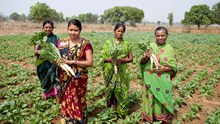
Vanilla originates from the orchid family, specifically the species Vanilla planifolia. Native to Mexico, this climbing vine produces beautiful, pale greenish-yellow flowers. Each flower blooms for a mere day, presenting a narrow window for pollination. The flower's structure is unique: while it possesses both male (anther) and female (stigma) reproductive organs, a thin membrane called the rostellum separates them, preventing self-pollination .
Natural Pollination: Role of the Melipona Bee
In its native habitat, the vanilla orchid relies on the Melipona bee, a small, stingless bee species, for pollination. These bees have evolved alongside the vanilla orchid, mastering the intricate task of navigating the flower's complex structure to facilitate pollination. However, the Melipona bee is endemic to Mexico, limiting natural pollination to this region
As vanilla cultivation expanded to regions like Madagascar, Indonesia, and Tahiti, the absence of the Melipona bee posed a significant challenge. Without its natural pollinator, vanilla production in these areas became nearly impossible, prompting the need for an alternative solution.
Advent of Hand Pollination
The breakthrough came in 1841 when Edmond Albius, a 12-year-old enslaved boy on the island of Réunion, discovered a method to manually pollinate the vanilla orchid. Using a thin stick or blade of grass, he lifted the rostellum and pressed the anther and stigma together, successfully mimicking the bee's role . This technique revolutionized vanilla cultivation, allowing it to flourish in regions beyond Mexico.
Hand Pollination Process
Hand pollination is a meticulous and labor-intensive task. Given that each flower opens for only a few hours on a single day, timing is crucial. Here's a step-by-step overview:
-
Identification: Monitor the vines daily to identify newly opened flowers.
-
Tool Preparation: Use a slender tool, like a toothpick or a fine-tipped bamboo stick.
-
Accessing Reproductive Organs: Gently lift the rostellum to expose the anther and stigma.
-
Pollination: Transfer the pollen from the anther to the stigma, ensuring contact.
-
Cross-checking: Within a few weeks, successfully pollinated flowers will develop into green pods, signalling the onset of vanilla bean formation.
Comparing Hand and Natural Pollination
When comparing hand pollination to natural pollination in vanilla cultivation, several distinct differences emerge in terms of efficiency, labor, and geographical flexibility. Natural pollination of vanilla primarily relies on the Melipona bee, which is native to parts of Central and South America. However, these bees are not widely present in all vanilla-growing regions, making natural pollination highly limited and often unpredictable. As a result, the efficiency of natural pollination is relatively low, with only a small percentage of flowers successfully producing beans.
In contrast, hand pollination offers a much more controlled and consistent approach. Each flower is individually pollinated by human hands, ensuring a significantly higher yield compared to relying on natural pollinators. This method allows farmers to manage the process carefully and maximize the output of vanilla beans from each plant.
However, this higher efficiency comes at the cost of increased labor. Hand pollination is an intensive process that demands daily attention during the flowering season. Since vanilla flowers open for only one day and must be pollinated within a short time frame, usually in the morning, growers must be vigilant, inspecting and pollinating flowers by hand every day to avoid missing the narrow window of opportunity.
Geographically, natural pollination is inherently restricted to areas where Melipona bees exist, which severely limits the potential for large-scale vanilla cultivation in most parts of the world. Hand pollination, on the other hand, has revolutionized vanilla farming by making it possible to grow the crop in a wide range of climates and regions across the globe, from Madagascar to India and Indonesia. This adaptability has played a crucial role in the global expansion of vanilla production, allowing it to become one of the most widely used and sought-after flavoring agents worldwide.
Broader Implications
The reliance on hand pollination underscores the challenges of vanilla cultivation. It contributes to the spice's high market value and highlights the importance of skilled labor in agriculture. Moreover, it raises questions about sustainability and the need for innovations to reduce labor demands without compromising quality.
Vanilla's journey from orchid to extract is a testament to human ingenuity and adaptability. While nature provides the blueprint, it's the dedication and skill of cultivators that bring this beloved flavor to our tables. Understanding the intricacies of its pollination process deepens our appreciation for every drop of vanilla we enjoy.
















